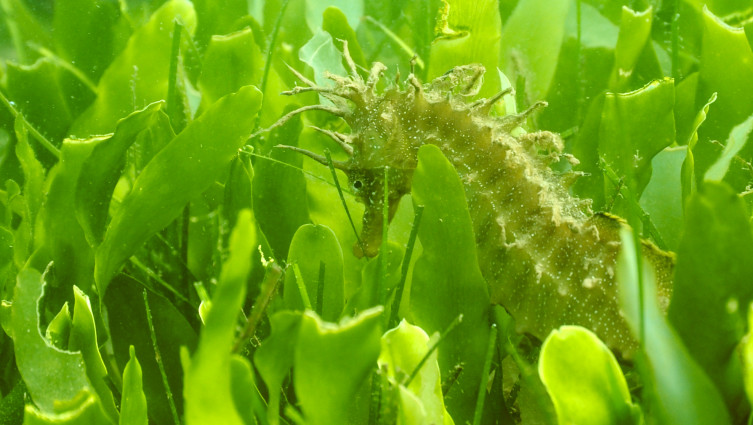Maritime marking of the Ria Formosa seahorses refuge in Culatra
The Minister for the Environment, João Pedro Matos Cordeiro and his team, visited yesterday the refuge area of seahorses in Culatra, where the maritime signage works have recently been concluded. This work is an essential step for the users of the Ria Formosa to recognize the refuge areas where navigation is not allowed, thus ensuring a more effective and continued preservation of the seahorses and their natural habitat in the Ria Formosa. The signposting of the seahorses' refuge areas is the result of a joint effort between the Regional Direction of Nature Conservation and Forests of the Algarve from the Instituto de Conservação da Natureza e das Florestas, the Centre of Marine Sciences of the Algarve (CCMAR) and the Almancil International Rotary Club.
What caused the 90% decrease of seahorses populations in Ria Formosa?
During the last decade, the populations of seahorses in the Ria Formosa have suffered a major decrease due to several factors arising from human activity in the estuary. One of these factors was the illegal fishing, motivated by the demand of these species to be sold in the Asian market as a very appreciated and valued product for the traditional Chinese medicine. This impact began to be detected between 2013-2015 and led to a sudden decrease in populations, which due to their biology and ecology are fully exposed to the fishing gear used.
In addition, illegal fishing (carried out by trawling) also has an indirect impact on the bottom of the Ria Formosa, which causes a marked environmental degradation and the quality of the preferred and available habitats for these species and others, the seagrass beds. Underwater noise pollution and natural silting phenomena (accumulation of debris) in areas near the bars were also identified as problems for the conservation of these species.
The creation of refuge areas to protect seahorses
After having identified and confirmed the drastic reduction of seahorse populations between the years 2018 and 2019, the Group for the Safeguarding and Conservation of Seahorse Populations in the Ria Formosa (Grupo para a Salvaguarda e Conservação da Populações de Cavalos Marinhos da Ria Formosa) was created. This group includes all local and national institutions that as a decisive power and in a joint act could help contribute to the mitigation of the damage already imposed and propose and implement conservation measures for the re-establishment of the seahorse populations in the Ria Formosa.
One of the first measures created by this group was the implementation of refuge areas also known as sanctuary zones for the seahorses. In a partnership between this group and the local fishermen associations two marine refuge areas were created, one in the area of Culatra (contiguous to the Olhão Channel) and another in the estuary of Geada (contiguous to the Faro Channel). With the creation of these areas, the intention was to contribute to the total protection of these species, but also to evaluate their usefulness, and with that the possible need to multiply these areas and thus create a protection network of reduced proximity, a determining factor for the biology of these species. The monitoring of the seahorse populations in the Ria Formosa as well as the refuge areas has been carried out through the HIPPOSAVE project (MAR2020 financing) of the University of Algarve.
A surprising increase in the number of seahorses in the Refuge Areas
During 2020 and 2022, monitoring campaigns were carried out to assess the status of the populations of the two seahorse species. It was concluded that between the years 2020 and 2021, the values recorded were quite low in agreement with the values observed in previous years. However, in 2022 a significant increase in the population of these species was recorded (six times higher compared to the campaigns of 2020 and 2021). Although it was found that in some of the 25 sites monitored, seahorses were still absent or present in small numbers, in other sites a significant increase was observed. This allowed accounting for a significant global increase in the abundance of seahorses now observed in the Ria Formosa.
The monitoring of the Refuge Areas also provided relevant data, with an increase in the number of seahorses in these areas. After the implementation of these areas in 2020 through the Captaincies' edicts (prerogative of the POPNRF), and in a pre-signposting phase, in 2021 the abundance of seahorses within the area was already as high (six times higher) as the one that came to be observed later in 2022 in the Ria, a value that has remained stable until today. In one of the Refuge Areas there was also a pilot intervention of environmental requalification (also operated under the HIPPOSAVE project) using artificial structures. In this area there was a higher abundance of seahorses that, reaching its peak of occurrence, had an abundance 100% higher than the surrounding area. This fact allowed us to conclude that the implementation of these areas is by itself beneficial to these species, but it becomes even more relevant when combined with the existence of an adequate habitat.
A promising future!
The improvement in the abundance values of these species is in itself a very positive and encouraging result for seahorse conservation. The implementation of protected areas, environmental improvement and awareness campaigns have also helped to contribute to the interest in protecting these species. It is, however, vital to keep a continuous monitoring of seahorse populations (inside and outside the Refuge Areas) in order to have updated information that allows managing the conservation measures in force and if necessary to reinforce them, trying to avoid a new situation of near disappearance as before. The maritime marking now carried out will contribute to a more effective and continued preservation of the refuge areas.
Another objective will be, in a next phase and considering the multiplier effect of these measures, to identify other areas that contribute to the increase of biodiversity and protection of natural values.



